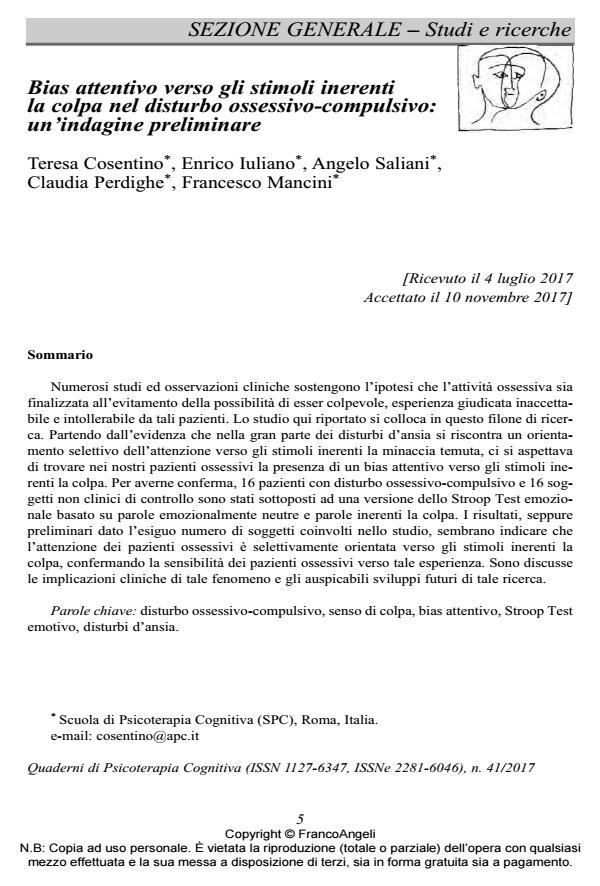Bias attentivo verso gli stimoli inerenti la colpa nel disturbo ossessivo-compulsivo: un’indagine preliminare
Titolo Rivista QUADERNI DI PSICOTERAPIA COGNITIVA
Autori/Curatori Teresa Cosentino, Enrico Iuliano, Angelo Saliani, Claudia Perdighe, Francesco Mancini
Anno di pubblicazione 2017 Fascicolo 2017/41
Lingua Italiano Numero pagine 13 P. 5-17 Dimensione file 163 KB
DOI 10.3280/QPC2017-041001
Il DOI è il codice a barre della proprietà intellettuale: per saperne di più
clicca qui
Qui sotto puoi vedere in anteprima la prima pagina di questo articolo.
Se questo articolo ti interessa, lo puoi acquistare (e scaricare in formato pdf) seguendo le facili indicazioni per acquistare il download credit. Acquista Download Credits per scaricare questo Articolo in formato PDF

FrancoAngeli è membro della Publishers International Linking Association, Inc (PILA)associazione indipendente e non profit per facilitare (attraverso i servizi tecnologici implementati da CrossRef.org) l’accesso degli studiosi ai contenuti digitali nelle pubblicazioni professionali e scientifiche
Numerosi studi ed osservazioni cliniche sostengono l’ipotesi che l’attività ossessiva sia finalizzata all’evitamento della possibilità di esser colpevole, esperienza giudicata inaccettabile e intollerabile da tali pazienti. Lo studio qui riportato si colloca in questo filone di ricerca. Partendo dall’evidenza che nella gran parte dei disturbi d’ansia si riscontra un orienta- mento selettivo dell’attenzione verso gli stimoli inerenti la minaccia temuta, ci si aspettava di trovare nei nostri pazienti ossessivi la presenza di un bias attentivo verso gli stimoli inerenti la colpa. Per averne conferma, 16 pazienti con disturbo ossessivo-compulsivo e 16 soggetti non clinici di controllo sono stati sottoposti ad una versione dello Stroop Test emozionale basato su parole emozionalmente neutre e parole inerenti la colpa. I risultati, seppure preliminari dato l’esiguo numero di soggetti coinvolti nello studio, sembrano indicare che l’attenzione dei pazienti ossessivi è selettivamente orientata verso gli stimoli inerenti la colpa, confermando la sensibilità dei pazienti ossessivi verso tale esperienza. Sono discusse le implicazioni cliniche di tale fenomeno e gli auspicabili sviluppi futuri di tale ricerca.
Parole chiave:Disturbo ossessivo-compulsivo, senso di colpa, bias attentivo, Stroop Test emotivo, disturbi d’ansia.
Teresa Cosentino, Enrico Iuliano, Angelo Saliani, Claudia Perdighe, Francesco Mancini, Bias attentivo verso gli stimoli inerenti la colpa nel disturbo ossessivo-compulsivo: un’indagine preliminare in "QUADERNI DI PSICOTERAPIA COGNITIVA" 41/2017, pp 5-17, DOI: 10.3280/QPC2017-041001